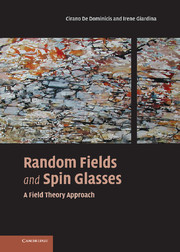Book contents
- Frontmatter
- Contents
- Preface
- List of abbreviations
- 1 A brief introduction
- 2 The Random Field Ising Model
- 3 The dynamical approach
- 4 The p = 2 spherical model
- 5 Mean field spin glasses: one-step RSB
- 6 The Sherrington–Kirkpatrick Model
- 7 Mean field via TAP equations
- 8 Spin glass above D = 6
- 9 Propagators, mostly replicon
- 10 Ward–Takahashi Identities and Goldstone modes
- 11 Alternative approaches and conclusions
- Appendix A Renormalization at one loop: ϕ4 theory (pure Ising)
- Appendix B Renormalization at one loop: tr ϕ3 theory (spin glass)
- Index
11 - Alternative approaches and conclusions
Published online by Cambridge University Press: 21 October 2009
- Frontmatter
- Contents
- Preface
- List of abbreviations
- 1 A brief introduction
- 2 The Random Field Ising Model
- 3 The dynamical approach
- 4 The p = 2 spherical model
- 5 Mean field spin glasses: one-step RSB
- 6 The Sherrington–Kirkpatrick Model
- 7 Mean field via TAP equations
- 8 Spin glass above D = 6
- 9 Propagators, mostly replicon
- 10 Ward–Takahashi Identities and Goldstone modes
- 11 Alternative approaches and conclusions
- Appendix A Renormalization at one loop: ϕ4 theory (pure Ising)
- Appendix B Renormalization at one loop: tr ϕ3 theory (spin glass)
- Index
Summary
The droplet picture
Throughout this book we have developed a spin glass field theory for the fluctuation field around the mean field RSB Parisi solution. The justification for such a theory, as we have stated at the beginning of our discussion, is intimately related to the validity in finite dimension of the nontrivial multi-ergodic physical scenario depicted by the mean field solution. Whether this is the case or not is still not clear. We have commented in the chapters previous to this conclusion what are the main features of the spin glass field theory, the consistency it exhibits, some reasonable extrapolations to dimensions lower than six and some possible predictions for measurable observables. Despite the great effort and the rich results obtained so far, the validity of the theory in three dimensions is still, however, a debated point, as much as the assumption of a nontrivial spin glass state at low temperature. It therefore seems important to us to briefly mention a few alternative points of view where the low temperature phase has different features from the ones we have extensively described.
The droplet model
The richest and most interesting alternative picture for the EA model was developed along the years by various authors (Bray and Moore, 1984, 1986; McMillan, 1984; Fisher and Huse, 1986, 1987, 1988; Newman and Stein, 1992, 1996, 1998) and is generally referred to as the ‘droplet model’, from the Fisher and Huse paper of 1986. The physical scenario described by this model is in striking contrast to the mean field one.
- Type
- Chapter
- Information
- Random Fields and Spin GlassesA Field Theory Approach, pp. 193 - 200Publisher: Cambridge University PressPrint publication year: 2006



